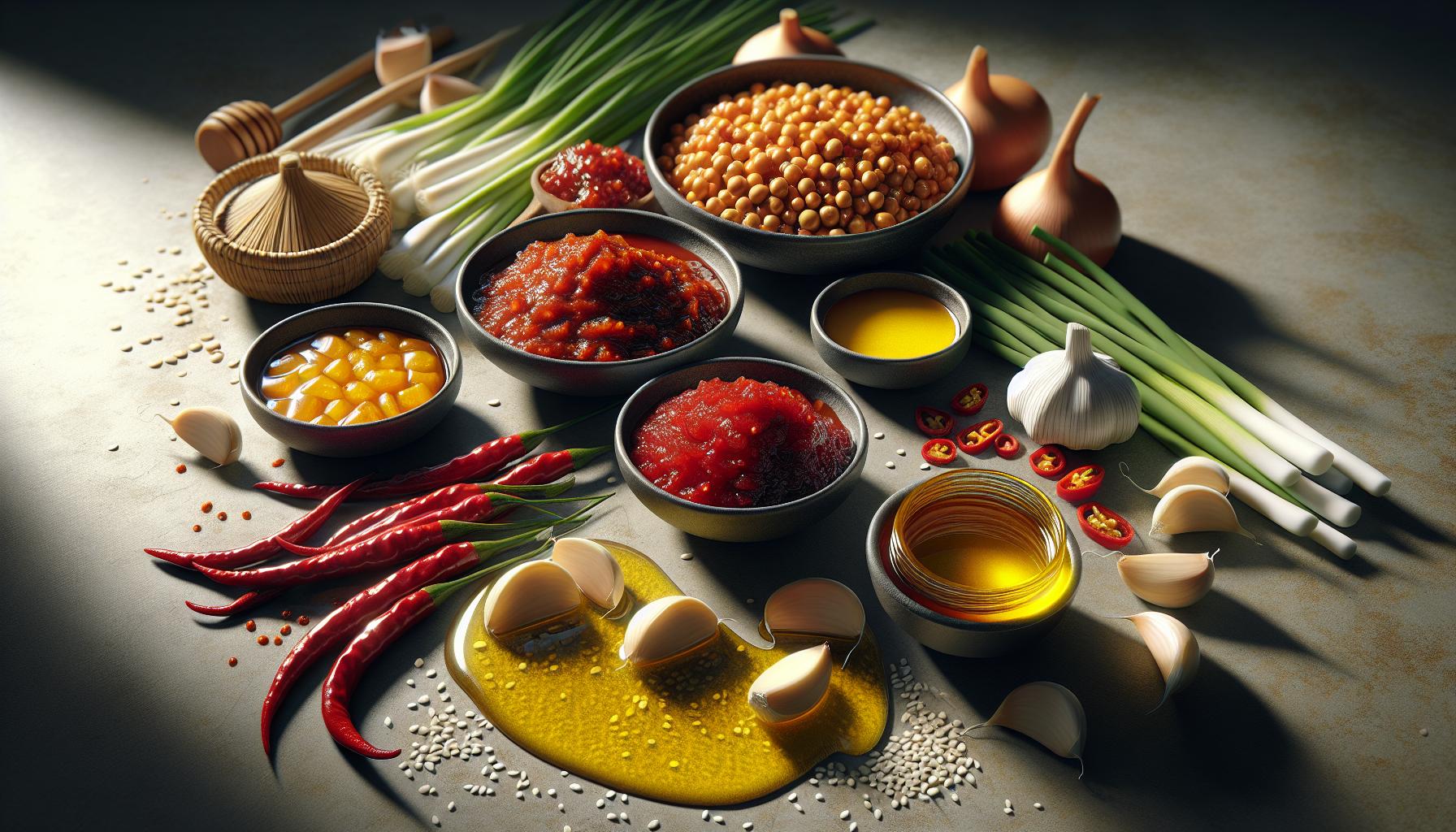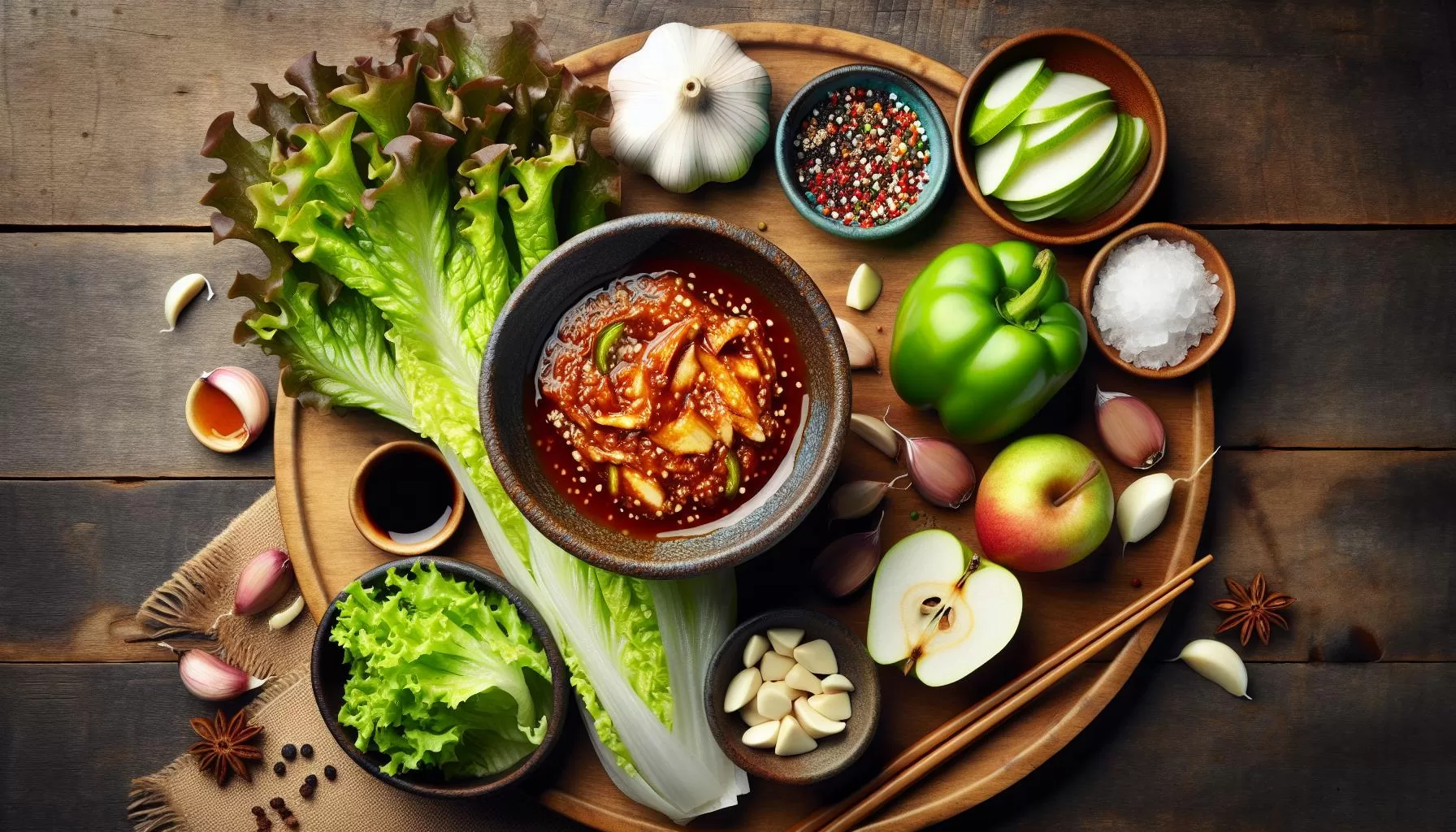What is Ssamjang Sauce?
If you’ve ever delved into the world of Korean BBQ, you’ll surely have met Ssamjang Sauce. It’s this thick, hearty paste that gives your lettuce wraps an unforgettable burst of flavor. Let’s unravel the mystery behind this essential Korean condiment and see why it deserves a spot in your culinary repertoire.
At its very core, Ssamjang is a savory, spicy, and slightly sweet sauce. It’s a blend of doenjang (Korean fermented soybean paste) and gochujang (Korean hot pepper paste). These two ingredients form the heart of Ssamjang, providing a unique flavor profile that’s hard to replicate.
The addition of other ingredients like garlic, onions, sesame seeds, and green onions give Ssamjang its depth. These tastes harmoniously merge, presenting a sauce that’s bursting with umami and tangy spice. Korean folks typically use Ssamjang in lettuce wraps – or ssam in Korean. But don’t feel boxed in! This versatile sauce adds a kick to any dish, be it grilled meat, vegetables, or rice.
Many opt for store-bought Ssamjang, mainly for the convenience factor. But once you’ve tasted homemade Ssamjang, it’s hard to go back. Making your own means you can adjust the sauce to your liking – more spice, less sugar, extra garlic… the choice is yours. Not to mention, homemade sauces often prove healthier, devoid of preservatives and excessive amounts of sodium.
Aside from its delectable taste, Ssamjang also packs a nutritional punch. Though the precise nutritional value varies depending on the ingredients and their proportions, we can provide some estimates in the table below:
| Food Component | Value per 100g |
|---|---|
| Calories | 225 |
| Protein | 10g |
| Carbohydrates | 30g |
| Fat | 7g |
Embrace the charm of Ssamjang, your dishes will thank you. It’s time you elevate your Korean cooking. So, ready to dive into making Ssamjang at home?
Key Ingredients for Homemade Ssamjang Sauce

When you’re making your own ssamjang sauce, you’ll want top-notch ingredients to ensure the best flavors. You shouldn’t cut corners here.
Doenjang (Korean soybean paste) is your first ingredient. You’ll need 2 tablespoons of this protein-packed paste. It’s a umami-rich anchor for this sauce, adding depth and character.
Next, add 1.5 tablespoons of Gochujang (Korean chili paste). It’s spicy, sure, but there’s a sweetness too that really sings. Just be careful with the heat, it’s a real firecracker.
Look for 1 tablespoon of honey next. You heard right, a little sweetness smooths the spicy edges. If you’re after something unusual, try substituting honey with fruit preserves. They give a rich, tangy pop that’s very much at home here.
Then reach for 2 cloves of minced garlic. Garlic and Korean food are best buds. Opt for fresh rather than store-bought minced garlic. Nothing beats that intense aroma and flavor.
A little sesame oil (1 tablespoon) carries those flavors nicely. This tiny amount makes a big difference. You’ll love the nutty warmth it brings to your ssamjang sauce.
Finally, 2 stalks of thinly chopped green onions and a sprinkle of sesame seeds are what you need. These add a fresh, herby zip to cut through all that intensity.
You might think about nutritional value too. Here’s a snapshot of how it stacks up per 100-gram serving:
| Ingredient | Calories | Protein | Carbohydrates | Fat |
|---|---|---|---|---|
| Doenjang | 157 | 12.4g | 16.6g | 5.4g |
| Gochujang | 255 | 7.5g | 47g | 4.4g |
| Honey | 304 | 0.3g | 82.4g | 0g |
| Garlic | 149 | 6.4g | 33.1g | 0.5g |
| Sesame oil | 884 | 0g | 0g | 100g |
| Green onions | 32 | 1.8g | 7.3g | 0.2g |
| Sesame seeds | 565 | 17.7g | 25.7g |
Step-by-Step Guide to Making Ssamjang Sauce

Before we jump in, let’s round up the essentials. You’ll need Doenjang and Gochujang. These Korean chili pepper and soybean pastes come in at 132g and 100g respectively for this recipe. Get 34g of honey, two cloves of garlic, and 28g each of sesame oil, green onions, and sesame seeds. You’ve all the parts now, let’s get assembling!
Start by mincing the garlic and chopping the green onions. Keep your strokes steady, you want everything in small, even pieces. It’s all about texture here. While you’re at it, set aside some sliced green onions – they’ll add a bit of crisp freshness to your final sauce.
Proceed by combining the Doenjang and Gochujang. It’s in the blend of these two core ingredients that the magic starts! A deep, complex flavor unfolds, setting the stage for additional elements. Add in the minced garlic and honey – they bring a savory-sweet balance.
Pour in the sesame oil, mix it well with the pastes. It binds everything together and adds a hint of nuttiness. Add your chopped green onions and sesame seeds. Now stir it up! You’re in for a treat, as the green onions give a bright pop, while the seeds offer a delightful crunch.
Voila! Here’s the thing – your homemade ssamjang is ready. But hold on! What about those additional flavors I’ve was talking about? Here’s a tip. Can you get your hands on a bit of grated Asian pear or apple? If you can, add about a tablespoon into the mix. It’s optional but trust me, that touch of fruity sweetness adds a whole new dimension, making your ssamjang truly unique.
Don’t worry about storing your ssamjang. Simply slip it into an air-tight container and into your fridge. It’ll be good for up to a week, giving you plenty of time to enjoy this homemade marvel with your meals.
Tips and Tricks for Perfecting Your Ssamjang

Making the perfect Ssamjang sauce is more than just about adding ingredients. It’s about how you’re going to combine them, the quality, and sometimes altering the ingredients to suit your taste. Let’s dive in.
Quality Ingredients Make Quality Ssamjang. As with all recipes, the quality of your Ssamjang mainly comes down to the quality of your ingredients. As a rule, always use the freshest and the best ingredients you can afford. There’s a noticeable difference in flavor between freshly grinded sesame seeds and the pre-packaged variety. The same goes for green onions. Cut them fresh before serving for that crisp taste, and you’ll notice a world of difference.
Balance is Key. Ssamjang is all about the delicate balance between salty, sweet, and savory flavors. When you’re making this sauce, don’t be afraid to taste as you go and adjust accordingly. More honey can add sweetness if you find it too pungent. If it’s too sweet, a dash more of Doenjang will balance it out. You’re the chef; you dictate the flavor balance.
Experiment with Additional Ingredients. There’s plenty of room for creativity when it comes to crafting your unique Ssamjang sauce. Grated Asian pear or apple can give a complex, fruity undertone. Onions can add an extra savory layer while a sprinkle of red pepper flakes can spice it up. Don’t be afraid to experiment and see what works best with your palate.
Storage Matters. Once you’ve made your perfect batch of Ssamjang, don’t forget about storing it properly. This sauce can last for up to a week in the fridge if stored correctly. Always store it in an airtight container to maintain freshness and prevent fridge odors from seeping in. The longer it sits, the more the flavors meld together.
There you have it. With these tips and tricks, you’ll be on your way to creating a unique and delicious Ssamjang that is sure to impress. Remember, cooking is about personal interpretation. So go ahead and get creative with your Ssamjang sauce. The sky really is the limit.
Conclusion
So, you’ve journeyed through the art of making Ssamjang sauce for Korean lettuce wraps. You’ve learned the importance of high-quality ingredients and how to strike that perfect balance of flavors. You’ve seen how a touch of grated Asian pear or apple can elevate your sauce to new heights. Most importantly, you’ve discovered that making Ssamjang sauce isn’t just about following a recipe – it’s about adding your own personal touch. Remember, the best Ssamjang sauce is the one that tastes best to you. So don’t be afraid to experiment and make it your own. Proper storage techniques will ensure your homemade Ssamjang sauce stays fresh and flavorful. Now, it’s your turn to whip up a batch of this delicious sauce and make your Korean lettuce wraps truly unforgettable. Enjoy the journey and happy cooking!

